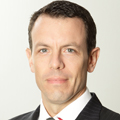ETFs looking more attractive… for big funds too
(Pictured: Jon Howie)
The democratisation of access to investment markets which has followed the rise of consumer choice around the world is continuing to force changes in investment management and the management of big super funds. Take what’s happening in the expanding ETF sector as an example.
ETFs are far from new but they were slow to take off in Australia compared with the US until the last few years. And while institutional investors have used them opportunistically – to tilt portfolios tactically, hedge risks during transitions and so forth – the real driver of late has been the self-directed investor.
The ever-increasing number of SMSFs, which may or may not continue and may or may not go into reversal as the population ages, is being joined by an increasing number of big funds offering member-directed investment options (MDIOs).
While most MDIOs do not yet offer ETFs on their menu, this is considered only a matter of time. The big funds are likely to augment this, in time, with their own model portfolios, too. It seems that several groups of participants are likely to get involved to further lift the ETF sector, aided by more sophisticated new ways which indices are being constructed.
Jon Howie, director of iShares at BlackRock in Australia, says that traditional stock brokers are “coming to the table” over ETFs, because of the realisation that selecting single stocks for clients is only a part of their value proposition.
He splits the usage of ETFs into three categories: investors who are looking for “precision exposures”, such as a single country or asset class; investors who like to build an entire balanced portfolio using ETFs, which can be done for as low as 21bps, he says; and investors who like to blend some ETFs with their active portfolios.
“It’s the third area where we are increasingly seeing brokers’ interest. It’s a powerful proposition [to tell clients],” he says.
Howie does not take sides in the active-versus-passive debate. He points out that passive wouldn’t work if there was no active and that active managers have been shown to outperform in many asset classes, sub-classes and markets. Nevertheless, the academic literature for major and more efficient markets is very supporting of passive management.
The “access” argument is probably what has interested self-directed investors most about ETFs until now. Single-country managed funds are still thin on the ground, getting research on and buying individual foreign stocks can be difficult or expensive and daily liquidity is hard to find. ETFs can ease those concerns.
More recently, new strategies in index management, such as the RAFI fundamental indices and equal-weighted indices which are not beholden to market-cap influences, and the growing realization that the ‘low beta phenomenon’ may be a permanent risk premium (see separate report, this edition, from Research Affiliates), are providing extra reasons to look at ETFs.
The new indices are basically more sophisticated versions of the old style indices and tilts. They are generally called ‘smart beta’. BlackRock calls them ‘strategy beta’. In the US, active ETFs are permitted by the exchanges, but not in Australia. BlackRock has two of them and Howie is not convinced of their merits. He says: “They may be a solution looking for a problem.”
The strategy beta ETFs are proving increasingly popular and this is a high-growth segment of the ETF market. BlackRock launched “minimum volatility” funds a couple of years ago, Howie says, and their popularity has been largely driven by institutional and more sophisticated clients to date.
BlackRock is the largest provider of ETFs in the world, with more than 700. It is not the largest in Australia, however. That mantle goes to State Street, in terms of trading volume, which was the first to the local market. There are also other providers such as Vanguard and the specialist firm Beta Shares.
BlackRock has 26 Australian-listed ETFs, 19 of which are for overseas markets. It has some dual-listed ETFs, such as that which tracks the US S&P 500. Because of the scale afforded by the US listing, the S&P fund can be bought by Australian investors at the same price: 7bps.
BlackRock even has an old US-listed Australian shares ETF, but it decided not to have this dual listed for Australian investors, which would have been a lot cheaper and easier, because of the franking credits situation, which are not available to foreign investors.
Not all ETFs are alike, of course, in their construction, and investors need to be as wary as they are in buying managed funds. Some are less liquid than you might think, with wider buy/sell spreads. Those which use synthetics may also have additional risks. None of BlackRock’s Australian-listed funds use synthetics but some of its offshore-listed funds do. Howie says the company’s policy is to use physical securities where possible, unless the synthetics are far more efficient, such as with commodities.










